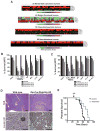A drug repositioning approach identifies tricyclic antidepressants as inhibitors of small cell lung cancer and other neuroendocrine tumors
- PMID: 24078773
- PMCID: PMC3864571
- DOI: 10.1158/2159-8290.CD-13-0183
A drug repositioning approach identifies tricyclic antidepressants as inhibitors of small cell lung cancer and other neuroendocrine tumors
Abstract
Small cell lung cancer (SCLC) is an aggressive neuroendocrine subtype of lung cancer with high mortality. We used a systematic drug repositioning bioinformatics approach querying a large compendium of gene expression profiles to identify candidate U.S. Food and Drug Administration (FDA)-approved drugs to treat SCLC. We found that tricyclic antidepressants and related molecules potently induce apoptosis in both chemonaïve and chemoresistant SCLC cells in culture, in mouse and human SCLC tumors transplanted into immunocompromised mice, and in endogenous tumors from a mouse model for human SCLC. The candidate drugs activate stress pathways and induce cell death in SCLC cells, at least in part by disrupting autocrine survival signals involving neurotransmitters and their G protein-coupled receptors. The candidate drugs inhibit the growth of other neuroendocrine tumors, including pancreatic neuroendocrine tumors and Merkel cell carcinoma. These experiments identify novel targeted strategies that can be rapidly evaluated in patients with neuroendocrine tumors through the repurposing of approved drugs.
Significance: Our work shows the power of bioinformatics-based drug approaches to rapidly repurpose FDA-approved drugs and identifies a novel class of molecules to treat patients with SCLC, a cancer for which no effective novel systemic treatments have been identified in several decades. In addition, our experiments highlight the importance of novel autocrine mechanisms in promoting the growth of neuroendocrine tumor cells.
©2013 AACR.
Conflict of interest statement
Figures






Comment in
-
Teaching an old dog new tricks: drug repositioning in small cell lung cancer.Cancer Discov. 2013 Dec;3(12):1333-5. doi: 10.1158/2159-8290.CD-13-0790. Cancer Discov. 2013. PMID: 24327694 Free PMC article.
Similar articles
-
Teaching an old dog new tricks: drug repositioning in small cell lung cancer.Cancer Discov. 2013 Dec;3(12):1333-5. doi: 10.1158/2159-8290.CD-13-0790. Cancer Discov. 2013. PMID: 24327694 Free PMC article.
-
Auranofin inhibition of thioredoxin reductase sensitizes lung neuroendocrine tumor cells (NETs) and small cell lung cancer (SCLC) cells to sorafenib as well as inhibiting SCLC xenograft growth.Cancer Biol Ther. 2024 Dec 31;25(1):2382524. doi: 10.1080/15384047.2024.2382524. Epub 2024 Jul 25. Cancer Biol Ther. 2024. PMID: 39054566 Free PMC article.
-
Dopamine D2 receptor agonists abrogate neuroendocrine tumour angiogenesis to inhibit chemotherapy-refractory small cell lung cancer progression.Cell Death Dis. 2025 May 9;16(1):370. doi: 10.1038/s41419-025-07693-y. Cell Death Dis. 2025. PMID: 40346068 Free PMC article.
-
Novel targeted strategies to overcome resistance in small-cell lung cancer: focus on PARP inhibitors and rovalpituzumab tesirine.Expert Rev Anticancer Ther. 2019 Jun;19(6):461-471. doi: 10.1080/14737140.2019.1624530. Epub 2019 May 31. Expert Rev Anticancer Ther. 2019. PMID: 31148500 Review.
-
Challenging the recalcitrant disease-developing molecularly driven treatments for small cell lung cancer.Eur J Cancer. 2019 Sep;119:132-150. doi: 10.1016/j.ejca.2019.04.037. Epub 2019 Aug 21. Eur J Cancer. 2019. PMID: 31445197 Review.
Cited by
-
Mechanism of chronic stress to promote tumor development and the intervention.Zhong Nan Da Xue Xue Bao Yi Xue Ban. 2022 Sep 28;47(9):1281-1288. doi: 10.11817/j.issn.1672-7347.2022.210589. Zhong Nan Da Xue Xue Bao Yi Xue Ban. 2022. PMID: 36411713 Free PMC article. Chinese, English.
-
Machine and deep learning approaches for cancer drug repurposing.Semin Cancer Biol. 2021 Jan;68:132-142. doi: 10.1016/j.semcancer.2019.12.011. Epub 2020 Jan 3. Semin Cancer Biol. 2021. PMID: 31904426 Free PMC article. Review.
-
Neuronal life or death linked to depression treatment: the interplay between drugs and their stress-related outcomes relate to single or combined drug therapies.Apoptosis. 2019 Oct;24(9-10):773-784. doi: 10.1007/s10495-019-01557-5. Apoptosis. 2019. PMID: 31278507 Free PMC article.
-
Teaching an old dog new tricks: drug repositioning in small cell lung cancer.Cancer Discov. 2013 Dec;3(12):1333-5. doi: 10.1158/2159-8290.CD-13-0790. Cancer Discov. 2013. PMID: 24327694 Free PMC article.
-
Ibrutinib Blocks YAP1 Activation and Reverses BRAF Inhibitor Resistance in Melanoma Cells.Mol Pharmacol. 2022 Jan;101(1):1-12. doi: 10.1124/molpharm.121.000331. Epub 2021 Nov 3. Mol Pharmacol. 2022. PMID: 34732527 Free PMC article.
References
-
- Ashburn TT, Thor KB. Drug repositioning: identifying and developing new uses for existing drugs. Nature reviews Drug discovery. 2004;3:673–83. - PubMed
Publication types
MeSH terms
Substances
Grants and funding
LinkOut - more resources
Full Text Sources
Other Literature Sources
Medical
Molecular Biology Databases

